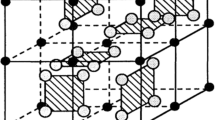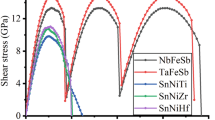Abstract
The mechanical properties of the CoSb3/Ti interface play a critical role in the application of thermoelectric devices. To understand the failure mechanism of the CoSb3(001)/Ti(01\( \bar{1} \)0) interface, we investigated its response during tensile deformations by first-principles calculations. By comparison with the result between the perfect interface and the interface after atomic migration, we find that the atomic migration at the interface has an obvious influence on the mechanical properties. The tensile tests indicate the ideal tensile stress of the CoSb3/Ti interface after atomic migration decreases by about 8.1% as compared to that of the perfect one. The failure mechanism of the perfect CoSb3/Ti interface is different from that of the migrated CoSb3/Ti interface. For the perfect CoSb3/Ti interface, the breakage of the Co-Sb bond leads to the failure of the system. For the CoSb3/Ti interface after atomic migration, the breakage of the Sb-Sb bond leads to the failure of the system. This is mainly because the new ionic Ti-Sb bonds make the electrons redistributed and weaken the stiffness of the Co-Sb bonds.
Similar content being viewed by others
References
G.J. Snyder and E.S. Toberer, Nat. Mater. 7, 105 (2008).
Z.H. Ge, L.D. Zhao, D. Wu, X. Liu, B.P. Zhang, J.F. Li, and J. He, Mater. Today 19, 227 (2016).
X. Zhang and L.D. Zhao, J. Materiomics 1, 92 (2015).
D. Champier, Energy Convers. Manag. 140, 167 (2017).
L.D. Zhao, V.P. Dravid, and M.G. Kanatzidis, Energy Environ. Sci. 7, 251 (2014).
J. He, M.G. Kanatzidis, and V.P. Dravid, Mater. Today 16, 166 (2013).
Y. Tang, Y. Qiu, L. Xi, X. Shi, W. Zhang, L. Chen, S.M. Tseng, S. Chen, and G.J. Snyder, Energy Environ. Sci. 7, 812 (2014).
G. Rogl and P. Rogl, Curr. Opin. Green Sustain. Chem. 4, 50 (2017).
K.H. Bae, S.M. Choi, K.H. Kim, H.S. Choi, W.S. Seo, I.H. Kim, S. Lee, and H.J. Hwang, J. Electron. Mater. 44, 2124 (2015).
D. Zhao, H. Geng, and L. Chen, Int. J. Appl. Ceram. Technol. 9, 733 (2012).
D. Zhao, M. Zuo, Z. Wang, X. Teng, and H. Geng, Appl. Surf. Sci. 305, 86 (2014).
D. Zhao, X. Li, L. He, W. Jiang, and L. Chen, J. Alloys Compd. 477, 425 (2009).
D. Zhao, H. Geng, and X. Teng, J. Alloys Compd. 517, 198 (2012).
L. Shi, X. Huang, M. Gu, and L. Chen, Surf. Coat. Technol. 285, 312 (2016).
G. Li, S. Hao, U. Aydemir, M. Wood, W.A. Goddard, P. Zhai, Q. Zhang, and G.J. Snyder, ACS Appl. Mater. Interfaces 8, 31968 (2016).
L. Hui, L. Yuping, Z. Caili, D. Nan, L. Hongfei, D. Hongbiao, and H. Peide, Comput. Mater. Sci. 82, 367 (2014).
H.Z. Zhang, L.M. Liu, and S.Q. Wang, Comput. Mater. Sci. 38, 800 (2007).
X. Guo and F. Shang, Comput. Mater. Sci. 50, 1711 (2011).
D. Yin, Y. Yang, X. Peng, Y. Qin, and Z. Wang, Ceram. Int. 40, 14453 (2014).
J. Li, S. Xu, J. Zhang, L. Liu, Q. Liu, W. She, and Z. Fu, Chin. Phys. B 26, 047101 (2017).
W. She, Q. Liu, H. Mei, P. Zhai, J. Li, and L. Liu, J. Electron. Mater. 46, 2929 (2017).
G. Kresse and J. Furthmüller, Phys. Rev. B 54, 11169 (1996).
G. Kresse and J. Furthmüller, Comput. Mater. Sci. 6, 15 (1996).
J. Perdew, K. Burke, and M. Ernzerhof, Phys. Rev. Lett. 77, 3865 (1996).
J. Zhou, D. Causon, C. Mingham, and D. Ingram, J. Comput. Phys. 168, 1 (2001).
P.E. Blöchl, Phys. Rev. B 50, 17953 (1994).
G. Li, Q. An, W. Li, W.A. Goddard, P. Zhai, Q. Zhang, and G.J. Snyder, Chem. Mater. 27, 6329 (2015).
M. Gu, X. Xia, X. Li, X. Huang, and L. Chen, J. Alloys Compd. 610, 665 (2014).
Author information
Authors and Affiliations
Corresponding author
Rights and permissions
About this article
Cite this article
She, W., Liu, Q., Mei, H. et al. First-Principles Study on the Tensile Properties and Failure Mechanism of the CoSb3/Ti Interface. J. Electron. Mater. 47, 3210–3217 (2018). https://doi.org/10.1007/s11664-017-5930-x
Received:
Accepted:
Published:
Issue Date:
DOI: https://doi.org/10.1007/s11664-017-5930-x




